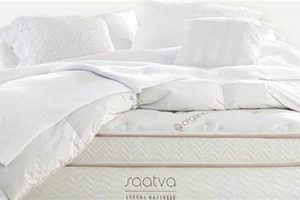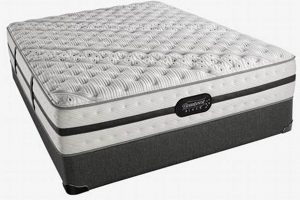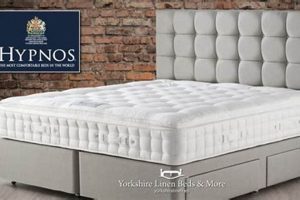The suitability of a sleep surface significantly impacts spinal alignment and pressure point relief, particularly for individuals who alternate between prone and lateral sleeping positions. Achieving optimal comfort and support necessitates a mattress that accommodates the distinct needs of both orientations. Considerations include surface firmness, material responsiveness, and the degree of contouring offered to different body regions.
Proper support can minimize discomfort and potential long-term musculoskeletal issues. Historically, mattress design often prioritized either stomach or side sleeping, forcing combination sleepers to compromise. Modern advancements in sleep technology now offer designs aimed at delivering balanced support and minimizing pressure buildup, contributing to improved sleep quality and overall well-being.
The following sections will explore key mattress characteristics ideal for those who sleep on their stomach and side, examining various mattress types and material compositions alongside factors that influence their performance in facilitating a comfortable and supportive sleep experience.
Selecting a Suitable Sleep Surface
Choosing a mattress requires careful consideration to accommodate the biomechanical demands of both stomach and side sleeping postures. The following points outline key aspects to evaluate during the selection process.
Tip 1: Prioritize Spinal Alignment. The chosen mattress should maintain a neutral spinal position, preventing excessive curvature in either the prone or lateral position. Evaluate mattress firmness by lying in both preferred sleeping positions to assess spinal alignment.
Tip 2: Consider a Medium-Firm Feel. A medium-firm mattress generally offers sufficient support for stomach sleepers while providing adequate contouring for side sleepers. Avoid excessively soft surfaces, which may contribute to spinal hyperextension when lying prone.
Tip 3: Evaluate Pressure Relief. Side sleeping places concentrated pressure on the shoulders and hips. Examine the mattress’s ability to distribute weight and minimize pressure points, particularly in these areas. Materials like memory foam or latex can enhance pressure relief.
Tip 4: Assess Edge Support. Strong edge support prevents mattress sagging and provides a stable surface for sleeping near the edge. This is especially beneficial for combination sleepers who move frequently during the night.
Tip 5: Research Material Composition. Different materials offer varying levels of support, contouring, and temperature regulation. Consider individual preferences and needs when evaluating mattress materials such as innerspring, memory foam, latex, or hybrid constructions.
Tip 6: Trial Period Utilization. Take advantage of any available trial period to thoroughly assess the mattress’s suitability. Spending sufficient time sleeping on the mattress is crucial to determining its long-term comfort and support.
Tip 7: Examine Mattress Construction. A mattress designed with zoned support can provide targeted firmness in specific areas, accommodating the different needs of stomach and side sleeping. Look for mattresses with reinforced lumbar support.
Selecting the appropriate sleep surface is a crucial step in promoting proper spinal health and ensuring restful sleep. Carefully considering these factors will aid in identifying a mattress that adequately supports both sleeping postures.
The next section will explore the various mattress types available and delve deeper into material properties that influence their suitability for combination sleepers.
1. Firmness
Firmness is a crucial determinant in the suitability of a sleep surface for individuals who alternate between stomach and side sleeping positions. The ideal firmness level provides adequate support to maintain spinal alignment in both postures, preventing discomfort and potential long-term musculoskeletal issues. A mattress that is either too soft or too firm can exacerbate pressure points and compromise sleep quality.
- Spinal Alignment for Stomach Sleepers
Stomach sleeping often leads to spinal hyperextension if the mattress is too soft, as the midsection sinks excessively. This can strain the lower back. Therefore, a firmer surface is generally recommended to keep the spine relatively straight. However, excessive firmness can create pressure points and discomfort.
- Spinal Alignment for Side Sleepers
Side sleeping places concentrated pressure on the shoulders and hips. A mattress that is too firm will not allow these areas to sink in sufficiently, leading to pressure buildup and potential pain. Conversely, a surface that is too soft will cause excessive sinkage, misaligning the spine. A balance is required to provide adequate contouring without compromising spinal support.
- The Medium-Firm Compromise
A medium-firm mattress often represents the optimal compromise for combination sleepers. This firmness level typically offers sufficient support for stomach sleeping while providing enough give to relieve pressure points in the side sleeping position. Actual perceived firmness, however, varies depending on individual body weight and personal preferences.
- Zoned Support Systems
Mattresses with zoned support offer varied firmness levels across different areas of the sleep surface. This design approach can address the differing support needs of stomach and side sleepers by providing firmer support in the lumbar region for stomach sleeping and softer zones for pressure relief in the shoulder and hip areas during side sleeping. These systems enhance the adaptability of the mattress to different sleeping postures.
The selection of an appropriate mattress firmness is paramount for individuals who switch between stomach and side sleeping. A medium-firm surface or a mattress with zoned support provides a balanced approach, minimizing spinal misalignment and pressure points regardless of the sleeping position assumed. Trial periods are recommended to ensure subjective comfort and suitability.
2. Spinal Alignment
Maintaining proper spinal alignment during sleep is crucial for overall musculoskeletal health and comfort. The appropriateness of a sleep surface is directly linked to its ability to support the natural curvature of the spine, particularly for individuals who alternate between stomach and side sleeping positions. This necessitates a mattress that can adapt to differing support requirements based on sleeping posture.
- Stomach Sleeping and Lumbar Support
Stomach sleeping can often lead to hyperextension of the lumbar spine if the mattress is too soft, resulting in lower back pain. A firmer sur
face is generally recommended to prevent excessive sinking of the midsection, thereby maintaining a more neutral spinal alignment. However, excessive firmness can create pressure points, negating the benefits. The key lies in finding a balance that offers support without sacrificing comfort. - Side Sleeping and Shoulder/Hip Accommodation
Side sleeping places concentrated pressure on the shoulders and hips. A mattress that is too firm will not allow these areas to sink in sufficiently, leading to lateral spinal misalignment and pressure buildup. Conversely, a surface that is too soft will cause excessive sinkage, distorting the natural spinal curvature. Effective spinal alignment in this position requires a mattress with sufficient give to accommodate these pressure points while still providing overall support.
- The Role of Zoned Support Systems
Mattresses incorporating zoned support systems offer varying levels of firmness across different areas. These are designed to address the distinct support requirements of different sleeping postures. For instance, firmer support may be provided in the lumbar region to accommodate stomach sleeping, while softer zones are implemented in the shoulder and hip areas to alleviate pressure points during side sleeping. This individualized support contributes to improved spinal alignment in both positions.
- Impact of Mattress Materials
The materials used in mattress construction significantly influence their ability to promote spinal alignment. Memory foam, for example, contours to the body’s shape, potentially reducing pressure points. Latex offers a more resilient and supportive feel, while innerspring mattresses provide a traditional firmness. Hybrid mattresses combine different materials to leverage their respective benefits, potentially offering a balanced approach to spinal support and pressure relief for combination sleepers.
The selection of a mattress that effectively promotes spinal alignment for both stomach and side sleepers requires careful consideration of firmness levels, support systems, and material properties. The ultimate goal is to minimize spinal stress and promote a comfortable and restorative sleep experience, regardless of the sleeping position assumed throughout the night. Trial periods are crucial in determining subjective comfort and suitability.
3. Pressure Relief
The capacity of a sleep surface to alleviate concentrated pressure is paramount in determining its suitability, particularly for individuals who alternate between stomach and side sleeping. Inadequate pressure relief can lead to discomfort, disrupted sleep, and potentially contribute to musculoskeletal issues. A mattress that effectively distributes weight minimizes stress on specific body areas, fostering a more restorative sleep experience.
- Shoulder and Hip Accommodation in Side Sleeping
Side sleeping concentrates pressure on the shoulders and hips. A mattress designed to provide adequate pressure relief in these areas allows these bony prominences to sink in slightly, distributing weight more evenly and preventing the development of pressure points. Materials such as memory foam and latex are frequently employed for their pressure-relieving properties, conforming to the body’s contours and minimizing stress. Failure to address this can result in localized pain and discomfort, leading to tossing and turning throughout the night.
- Sternum and Pelvic Support in Stomach Sleeping
While stomach sleeping generally benefits from a firmer surface to maintain spinal alignment, some degree of pressure relief is still necessary for the sternum and pelvic region. Excessive pressure in these areas can lead to discomfort and impede restful sleep. Mattresses with targeted support zones or those incorporating a thin comfort layer can help to mitigate this issue by providing localized cushioning without compromising overall spinal support. Proper distribution of body weight is key to preventing unnecessary strain on these vulnerable areas.
- Material Properties and Pressure Redistribution
The materials used in mattress construction directly influence its ability to redistribute pressure. Memory foam excels at conforming to the body’s shape, effectively distributing weight across a wider surface area. Latex offers a more responsive and buoyant feel, providing pressure relief while maintaining support. Innerspring mattresses, while generally firmer, can incorporate comfort layers designed to alleviate pressure points. Hybrid mattresses often combine these materials to achieve a balance of support and pressure relief, catering to a wider range of sleeping preferences.
- Impact on Circulation and Tissue Health
Sustained pressure on specific body areas can impede circulation and potentially compromise tissue health. Mattresses that effectively alleviate pressure points promote healthy blood flow, contributing to improved sleep quality and overall well-being. This is particularly important for individuals with pre-existing circulatory issues or those prone to developing pressure ulcers. Choosing a mattress with adequate pressure relief features can mitigate these risks and promote a more comfortable and healthful sleep experience.
The successful integration of pressure relief mechanisms is a defining characteristic of a sleep surface suitable for individuals who switch between stomach and side sleeping positions. The ability to evenly distribute weight, minimize stress on vulnerable body areas, and promote healthy circulation are essential for achieving restful and restorative sleep. A mattress that effectively addresses these concerns contributes significantly to improved comfort, reduced pain, and enhanced overall well-being.
4. Edge Support
Edge support refers to the structural reinforcement of a mattress perimeter, designed to prevent collapse or excessive sinking when weight is applied near the edges. For individuals who alternate between stomach and side sleeping positions, robust edge support is a critical feature. Its presence directly influences usable sleep surface area and overall mattress stability. Without adequate edge support, the sleeper is confined to the center of the mattress, potentially restricting movement and causing discomfort, especially when changing sleeping positions. The effect is magnified for couples sharing the same bed, as diminished edge support further limits individual space.
The importance of edge support extends beyond mere convenience. Sagging edges compromise spinal alignment when sleeping near the perimeter, negating the benefits of a supportive core. For example, a stomach sleeper near the edge of a poorly supported mattress may experience increased lower back strain due to the uneven surface. Similarly, a side sleeper could find their shoulder unnaturally compressed as the edge collapses. Furthermore, individuals who use the edge of the mattress for sitting, such as when getting dressed, rely on adequate support to prevent instability and potential falls. The ability to sit comfortably on the edge is particularly important for those with mobility challenges.
In summary, edge support is an integral, albeit often overlooked, component of a mattress that effectively caters to both stomach and side sleepers. It directly influences usable sleep space, spinal alignment, and
overall mattress stability. Choosing a mattress with reinforced edges is paramount for those who value unrestricted movement, consistent support, and safe use of the entire sleep surface. Neglecting this aspect can diminish the overall benefits of even the highest-quality core materials and construction techniques.
5. Material Composition
The suitability of a mattress for individuals who sleep on both their stomach and side is significantly influenced by its material composition. The internal architecture and the materials selected directly impact factors such as spinal alignment, pressure relief, temperature regulation, and motion isolationall critical for achieving restful sleep in varying positions. The choice of materials must accommodate the differing support needs of stomach and side sleeping postures to qualify a mattress as appropriate for combination sleepers. Inadequate consideration of material properties can negate the benefits of advanced designs or construction techniques.
For instance, a mattress constructed primarily of low-density foam may offer initial comfort but lack the necessary support for stomach sleepers, leading to spinal hyperextension and lower back pain. Conversely, a mattress composed solely of firm innersprings may provide adequate support for stomach sleeping but fail to offer sufficient pressure relief for side sleepers, resulting in shoulder and hip discomfort. Hybrid mattresses, which combine elements such as innersprings with memory foam or latex, represent a common attempt to address these conflicting needs. The specific properties of each materialits density, firmness, and responsivenessdetermine the overall performance of the mattress. A well-designed hybrid mattress utilizes these materials strategically to create a balanced sleep surface.
In conclusion, material composition is a fundamental determinant of a mattress’s suitability for individuals who sleep on both their stomach and side. The strategic selection and arrangement of materials are paramount in achieving the necessary balance of support, pressure relief, and temperature regulation. While design and construction contribute to the overall performance, the inherent properties of the materials form the foundation upon which a comfortable and supportive sleep surface is built. Understanding the relationship between these materials and their impact on sleep quality is essential for making informed mattress purchasing decisions.
6. Motion Isolation
Motion isolation, the capacity of a mattress to minimize the transfer of movement across its surface, is a significant characteristic for individuals who share a bed and alternate between stomach and side sleeping positions. Disruptions caused by a partners movements can impede sleep continuity, affecting both sleep quality and overall well-being. For stomach and side sleepers, who often require specific levels of support and contouring, disturbances can be particularly detrimental as shifts in position may already be less frequent and more deliberate.
Mattresses with effective motion isolation help mitigate these disruptions. Memory foam and latex mattresses, for instance, are known for their ability to absorb movement at the point of impact, preventing it from propagating across the surface. Consider a scenario where one partner shifts from their side to their stomach. On a mattress with poor motion isolation, this shift would likely create a noticeable ripple effect, potentially waking the other partner. However, on a mattress with high motion isolation, the movement would be largely contained, allowing both individuals to maintain uninterrupted sleep. The practical significance extends to individuals who have different sleep schedules. A partner who goes to bed earlier or rises earlier can move around without significantly disturbing the other.
In conclusion, motion isolation serves as a key component in a sleep system designed to promote uninterrupted and restorative sleep for individuals with diverse sleeping patterns and preferences. Minimizing movement transfer contributes to a more stable and peaceful sleep environment, crucial for optimizing rest and well-being. While other mattress attributes like support and pressure relief are undeniably essential, the inclusion of effective motion isolation amplifies the benefits, particularly for those who share their sleep space.
7. Breathability
Breathability, the capacity of a mattress to facilitate air circulation and dissipate heat, is a crucial factor influencing sleep quality. Its importance is heightened for individuals who alternate between stomach and side sleeping positions due to the varying degrees of body contact and potential for heat retention associated with each posture. The microclimate created between the sleeper and the mattress directly impacts comfort and the ability to maintain a stable core body temperature throughout the night.
- Material Properties and Airflow
The materials used in mattress construction significantly affect breathability. Open-cell foam structures, such as those found in certain memory foam and latex formulations, promote airflow more effectively than closed-cell structures. Natural fibers like cotton and wool also contribute to breathability by wicking away moisture and facilitating air circulation. Conversely, dense, synthetic materials can impede airflow and trap heat, leading to discomfort and potential sleep disruption. The arrangement and layering of these materials further influence overall breathability performance.
- Stomach Sleeping and Surface Contact
Stomach sleeping often results in a greater surface area of contact with the mattress compared to other sleeping positions. This increased contact can restrict airflow and elevate body temperature, potentially leading to discomfort and sweating. Mattresses with enhanced breathability mitigate this effect by allowing heat to dissipate more readily, maintaining a cooler and more comfortable sleep environment. Individuals who tend to sleep hot may find mattresses with cooling technologies, such as infused gels or phase-change materials, particularly beneficial.
- Side Sleeping and Enclosed Spaces
While side sleeping may not involve as much surface contact as stomach sleeping, the position can create enclosed spaces between the body and the mattress, particularly around the shoulders and hips. These enclosed spaces can trap heat and moisture, leading to localized discomfort. Mattresses with good breathability help to prevent this buildup by promoting airflow and allowing moisture to evaporate, maintaining a more balanced and comfortable sleep temperature. The use of breathable mattress protectors and bedding can further enhance this effect.
- Impact on Sleep Quality and Thermoregulation
Effective breathability contributes to improved sleep quality by facilitating optimal thermoregulation. Maintaining a stable core body temperature is essential for initiating and maintaining sleep. Overheating can disrupt sleep cycles and lead to restlessness. Mattresses with good breathability help to prevent overheating by dissipating heat and allowing the body to regulate its temperature naturally. This is particular
ly important for individuals prone to night sweats or those living in warmer climates. The ability of a mattress to breathe effectively can significantly impact the overall sleep experience and contribute to a more restful and restorative night’s sleep.
In summary, breathability plays a crucial role in determining the suitability of a mattress for stomach and side sleepers. The capacity to facilitate air circulation, dissipate heat, and regulate temperature directly influences comfort and sleep quality. Mattresses constructed with breathable materials and designed to promote airflow are better equipped to meet the diverse needs of combination sleepers, ensuring a more comfortable and restorative sleep experience regardless of the position assumed throughout the night.
Frequently Asked Questions
The following section addresses common inquiries regarding mattress selection for individuals who alternate between stomach and side sleeping positions. The information aims to provide clarity and guidance in navigating the complexities of choosing an appropriate sleep surface.
Question 1: What firmness level is generally recommended?
A medium-firm mattress is often considered the optimal compromise. This firmness level typically provides sufficient support for stomach sleeping, preventing excessive spinal curvature, while offering enough give to relieve pressure points in the side-sleeping position. However, individual preferences and body weight should be considered when making a final determination.
Question 2: How does material composition impact suitability?
Material composition plays a crucial role in determining mattress performance. Memory foam offers pressure relief and contouring, while latex provides a more resilient and supportive feel. Innerspring mattresses tend to be firmer, and hybrid models combine different materials to achieve a balance of support and comfort. The choice of materials should align with individual needs and preferences.
Question 3: Is edge support a critical factor?
Yes, adequate edge support is essential, especially for those who share a bed. Strong edge support prevents mattress sagging and maximizes the usable sleep surface. This is particularly important for stomach and side sleepers who may shift positions frequently throughout the night.
Question 4: What role does spinal alignment play?
Maintaining proper spinal alignment is paramount for musculoskeletal health and comfort. The chosen mattress should support the natural curvature of the spine in both stomach and side-sleeping positions, minimizing stress and preventing the development of pain or discomfort.
Question 5: How can motion isolation affect sleep quality?
Effective motion isolation minimizes the transfer of movement across the mattress surface. This is particularly important for couples, as it reduces the likelihood of sleep disturbances caused by a partner’s movements. Materials such as memory foam and latex excel at absorbing motion.
Question 6: Is breathability a significant consideration?
Breathability, the capacity of a mattress to dissipate heat and facilitate airflow, is crucial for maintaining a comfortable sleep temperature. Materials that promote breathability, such as open-cell foam and natural fibers, help prevent overheating and promote restful sleep.
In summary, selecting the most appropriate mattress requires careful evaluation of firmness, material composition, edge support, spinal alignment, motion isolation, and breathability. Considering these factors will aid in identifying a sleep surface that adequately supports both stomach and side-sleeping positions, promoting improved sleep quality and overall well-being.
The following section provides a summary of key considerations when shopping for such a mattress.
Concluding Remarks
The preceding analysis has explored the multifaceted considerations involved in selecting a suitable sleep surface. Determining the best mattress for stomach and side sleepers requires careful assessment of firmness, material composition, spinal support, pressure relief, motion isolation, and breathability. These factors collectively influence sleep quality and overall musculoskeletal health. A successful selection will appropriately accommodate the biomechanical demands of both sleeping postures, minimizing discomfort and promoting restorative rest.
The information provided serves as a guide for making informed purchasing decisions. Further research and individual testing are encouraged to optimize the sleep environment. Prioritizing these considerations can significantly enhance sleep quality and contribute to long-term well-being, acknowledging that investing in a suitable mattress is an investment in personal health.





![Top Rated Best Feather and Down Mattress Toppers - [Year] Guide Organic & Natural Mattress Buyer’s Guide: Non-Toxic Sleep Solutions Top Rated Best Feather and Down Mattress Toppers - [Year] Guide | Organic & Natural Mattress Buyer’s Guide: Non-Toxic Sleep Solutions](https://mattressworldpa.com/wp-content/uploads/2025/07/th-7652-300x200.jpg)

